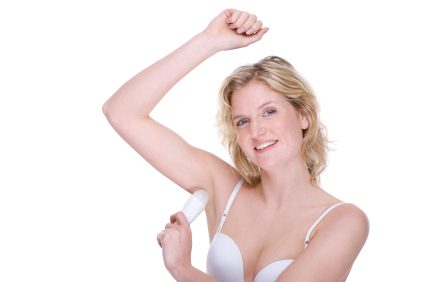The secret to keeping underarm odour at bay
Here’s the truth about deodorants, antiperspirants and doctor’s office treatments that claim to keep you dry and odour free

Source: Best Health Magazine, May 2011
The truth about sweat
Long before the first commercial deodorant‘called Mum’was invented in 1888, the ancient Egyptians tried to mask underarm odour with a blend of spices and oils, including cinnamon and citrus oils. We may not like to sweat, but it’s biologically essential, says Dr. Mark Lupin, a dermatologist in Victoria, and clinical instructor in the department of dermatology and skin science at the University of British Columbia. ‘It’s our main way of regulating body temperature,’ he explains. We emit sweat to cool down, though stressful situations, hormonal changes and certain medical conditions can trigger an increased production of fluid.
Still, sweat itself doesn’t smell. ‘It’s an odourless saltwater solution,’ says Dr. Nowell Solish, an assistant professor of dermatology at the University of Toronto and a founding board member of the International Hyperhidrosis Society. The smelly culprit is bacteria found on the skin’s surface. We all have two types of sweat glands: eccrine (which are found all over the body, and release just wetness), and apocrine (which are concentrated around the underarms, genitals, nipples and belly button). The latter type are associated with body odour because they release proteins and lipids that smell bad when broken down by bacteria‘and the armpits provide an especially ‘ moisture-rich environment, so they’re the perfect breeding ground for bacteria.
Are antiperspirants safe?
Some people believe that stopping perspiration under the armpits altogether, whether with a drugstore antiperspirant or a special treatment available at the doctor’s office, is dangerous because it doesn’t allow the skin to excrete toxins. But Lupin says sweating is not the primary method by which these materials exit the body (the main organs for processing toxins are the liver and kidneys).
‘Furthermore, [these remedies] are used only for small, localized areas of excessive sweating, and there is no evidence that they impact our body’s general ability to sweat.’ Since the underarm area comprises no more than five percent of our bodies’ total surface, there are plenty of other sweat glands through which to cool down.
What about other concerns? You may have heard that antiperspirants, which contain low doses of aluminum salts, have been linked to Alzheimer’s disease. But a link has never been proven, according to the Alzheimer’s Society of Canada. Parabens’a type of preservative used in some products’have also been a worry for some since one small study of 20 breast cancer patients found traces of them in tumour samples. ‘But the largest study that has been done’with more than 800 subjects’found no association between breast cancer and antiperspirants and deodorants,’ says Rick Gallagher, emeritus scientist with the B.C. Cancer Agency’s Cancer Control Research Program. ‘I think most people in the scientific community would consider this a non-issue.’
Here are the latest remedies and treatments:
To control odour
Examples: Axe Deodorant Stick; Byly ‘Sensitive Deodorant Stick with Silk Protein; Soft & Dri Aluminum Free
How they work: ‘Deodorants contain fragrances that help mask odour,’ says Lupin. They don’t decrease actual sweating. How effective they are, and for how long, depends on the product itself and how much you perspire, although some products employ additional anti-odour technologies to extend longevity and comfort.
Need to know: If you’re concerned about dampness, an antiperspirant or combined antiperspirant-deodorant is probably a better option.
To control wetness and odour
Examples: Ban Roll-On Antiperspirant; Degree Clinical MotionSense; Dove Ultimate Visibly Smooth Anti-Perspirant; Drysol Dab-On Anti-Perspirant Extra-Strong; Gillette 3X Clear Gel Antiperspirant Deodorant; Mitchum Roll-On Original Formula Anti-Perspirant and Deodorant; Old Spice Fresh Collection Antiperspirant and Deodorant; Secret Flawless Invisible Solid Antiperspirant
How they work: Most antiperspirants contain aluminum chloride. ‘This temporarily plugs the pores that emit sweat, and most also contain deodorizing ingredients,’ says Solish. They last from 12 to 24 hours and because the medication penetrates into the sweat glands, will usually endure through a shower. ‘The skin naturally replenishes itself and will get rid of the topical antiperspirants within a day or two,’ says Lupin. They’re also most effective when used on dry skin, so an ideal time to apply them is at night when, thanks to body temperature changes, we perspire less.
Need to know: In clinical-strength antiperspirants, such as Drysol Dab-On Anti-‘Perspirant Extra-Strong and Degree Clinical Strength with MotionSense, 20 percent of ‘the formulation is comprised of aluminium zirconium tetrachlorohydrex gly, the strongest percentage you can buy without a prescription. Degree’s formula also claims to release fragrance molecules as needed throughout the day. Extra-strength products can be irritating, so if you have sensitive skin, start with a small amount on one side for a week to see if your skin reacts, advises Lupin.
Some products have added benefits: Secret Flawless Invisible Solid Antiperspirant promises it won’t leave white marks thanks to its ‘light-reflecting ingredients’ that make the formula appear invisible. And Dove Ultimate Visibly Smooth Anti-Perspirant contains moisturizers that, over time, the company says, will help minimize the look and feel of underarm stubble (though they won’t actually reduce hair growth).
Natural options
Examples: Axel Kraft Natural Crystal Deodorant; Burt’s Bees Natural Skin Care ‘for Men Deodorant; Kiss My Face Liquid Rock Deodorant; Tom’s of Maine Original Care Deodorant Stick; Weleda Wild Rose Deodorant
How they work: ‘Natural deodorants control odour and kill some of the bacteria using natural fragrances and essential oils,’ says Gaetano Morello, a naturopathic doctor in Vancouver. ‘They’re also free of artificial fragrances, parabens and phthalates.’
Need to know: Some natural deodorants, including natural crystal ones, contain potassium alum (it may appear on the label as ‘alum’). ‘It’s still aluminum, and it works the same way as in other antiperspirants, by creating a plug in the sweat gland,’ says Lupin.




